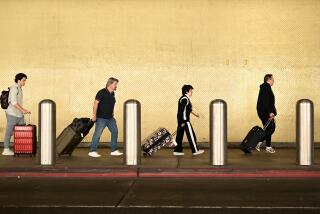New security measures at U.S. airports could slow you down this holiday travel season
If you’re getting on a plane during the holidays, the rules for security have changed. Again. And that turkey gravy you’re carrying? You can tote it in your carry-on — but not enough to feed a crowd. Here are some ground rules fliers should know lest they run afoul of what promises to be an exceptionally busy Thanksgiving travel season.
What’s up with electronics on domestic flights?
If you’re flying from our area airports, you’ll find stricter screening of electronic devices. LAX, Ontario, Long Beach and Orange County’s John Wayne are in this category, but Burbank is not ready, said Lorie Dankers, a Transportation Security Administration representative.
What does “stricter screening” mean?
Any electronics larger than a 4-by-6-inch cellphone must come out of your carry-on bag when you go through airport screening.
Tablet? Put it in a bin. Keyboard for your tablet or smartphone? Bin. E-reader? Bin. Large camera such as a DSLR? Bin. Laptop? Of course, a bin (and that’s not new). Electronic label maker? Bin. (You’re using it for place cards, right?)
Basically, Dankers said, any electronic device larger than the aforementioned size that has a battery and circuitry must be screened.
Isn’t that going to slow things down?
In the best of all possible worlds, it will not because you are prepared. You have all your electronics together and you can whip them out of your bag.
But be prepared for those who are not reading this column (and presumably other travel-related columns) because they may be surprised.
It’s also true that many people travel only once a year so they may be extra flummoxed by what has changed from last year.
Not you, of course. But here’s something that could trip you up: You aren’t used to having to take those things out of your bag so you may not remember to pick them up.
Dankers suggests keeping a mental checklist for your journey through security.
To that I would add something that retired LAPD Det. Kevin Coffey, an expert on travel safety, has drilled into my head: Put your name and contact information on your electronics just in case your mental checklist fails.
On my cellphones, I have created a lock-screen message that shows where to call if they’re found. You can find the tutorial that tells you how at lat.ms/customlockscreen.
The message also directs the finder to remove the case to find my business card. (Do not put your home address in there.)
Just as easily, you can tape your contact info to just about any object. Your chances of getting it back are far better, TSA and Coffey have told me.
But I have TSA PreCheck. Am I not exempt from this electronics screening?
You are. Until you’re not.
Here’s the deal with PreCheck, the expedited screening process that means you do not have to take off your light outer jacket, your belt or your shoes and usually means you can leave your liquids and electronics in your carry-on bag.
If you have PreCheck, available through TSA ($85 for five years at www.tsa.gov/precheck) or as part of Global Entry ($100 for five years and includes expedited screening at Customs at lat.ms/globalentryprecheck), you generally don’t have to do the security line juggling act.
But here’s when you do, and this just happened to me: If the PreCheck line is not in operation because there’s not enough traffic, you have to take out all that stuff.
I wasn’t expecting this and found myself in the line where the non-Pre folks dwell. I was scrambling to grab the tablet and the laptop.
As I was talking with Dankers, it dawned on me that I should have removed my portable keyboard and didn’t.
It wasn’t that my mental checklist failed me; it’s that I never thought of the keyboard. Nothing happened to me … this time.
But note to self and readers: Review what’s in your bag before your trip.
Is that it?
No. There’s one more important electronics piece of the puzzle and it’s this: Make sure those electronics are charged.
You may need them for boarding passes, your own entertainment and, with some security situations, to prove they are what you say they are.
If your most recent upgrade to your iPhone’s operating system is sucking the life out of your battery in record time, let me suggest an external battery charger.
They come in all shapes and sizes, including some about the dimensions of a credit card and less than half-an-inch thick. They’re slow and can give you only one charge, but they fit easily into a bag and the cord is often built-in.
They’re good to have anyway in case you encounter delays and need to make calls to alert the appropriate parties.
Second note to self and readers: Make sure you have saved the phone number of the airline you’re flying.
Now what about that gravy?
Yes, you can take gravy in your carry-on bag — if it weighs less than 3.4 ounces.
Unless you’re having the world’s tiniest turkey dinner, you’re going to need to pack that in your suitcase along with that fifth of vodka. (By the way, you may not transport, in carry-on or checked baggage, booze that’s 70% alcohol or more.)
Likewise, these things are not going to fly in your carry-on bag if they weigh more than 3.4 ounces: creamy cheese, dips and spreads, hummus, honey, ice cream (doesn’t matter the size — that’s a no in carry-on), jams or jellies, maple syrup, oil and vinegar or salad dressing, peanut butter, salsa, soup and more.
What about cakes and pies?
You can take cakes and pies, but as with all things, if they’re deemed suspicious they may not make the trip.
You can read more about carry-on allowables at lat.ms/oktocarryon.
If you’re still uncertain you can tweet or use Facebook Messenger (even send pictures) to reach TSA from 5 a.m. to 7 p.m. Pacific time on weekdays and 6 a.m. to 4 p.m. weekends and holidays.
I’m flying to the U.S. from a foreign airport. Anything I should know?
Last month the Department of Homeland Security implemented additional screening measures for fliers coming from abroad.
The good news: You can now carry your laptop in your carry-on. The ban that kept fliers coming from 10 countries without their laptops has been rescinded.
But you may be subjected to other questions and measures abroad.
What are they and when will I encounter them?
We can’t say for sure because Homeland Security doesn’t telegraph its chess moves; its website notes: “We cannot discuss specific timelines or measures, but some were required immediately, while others will be implemented over time, in coordination with our international partners.”
Whether domestically or internationally, what’s the most important thing to have with me?
Besides an external battery, good cheer. And we don’t mean the bottled kind.
Have a travel question or dilemma? Write to [email protected]. We regret we cannot answer every inquiry.
More to Read
Sign up for The Wild
We’ll help you find the best places to hike, bike and run, as well as the perfect silent spots for meditation and yoga.
You may occasionally receive promotional content from the Los Angeles Times.







